October 23, 2019
 by Georgios Chasiotis / October 23, 2019
by Georgios Chasiotis / October 23, 2019

If you’re already aware that you should be using linkable assets, are you maximizing the different types that currently exist?
In this article, we’ll be exploring some of the most popular linkable assets – the asset types that seem to be working well across different industries and verticals.
In our previous article, we discussed what linkable assets are and how to create them. This, however, focuses on the various types you need to learn how to use to the best of your ability. Learn all six to become a creative linkable assets expert!
Case studies tend to attract a lot of links for marketing-related websites.
This happens mainly for two reasons:
However, case studies are not easy to create. The results included in a case study should be truly astonishing, which is not something you see every day.
For instance, let’s take a look at the following case study from Leadfeeder’s blog.

Source: Leadfeeder
As you can see, the results presented here (8,400 new users per week) are truly remarkable and thus, Leadfeeder decided to create a case study around them.
The reason why this piece has links from 35 referring domains is exactly because it has shareable and link-worthy elements.
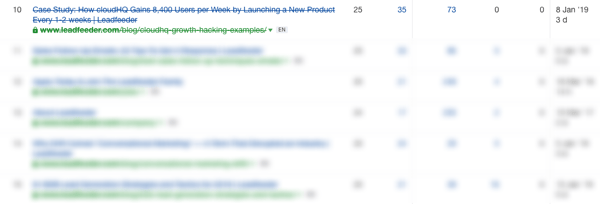
Source: Ahrefs UI
These results are usually hard to find, which is why you can’t produce case studies very often. Something you can do here is to create case studies for other companies and publish them on your own blog. The only thing you need to pay attention to is that they have to be relevant to what your audience wants and expects from you.
To find such content pieces online, you can use a simple Google Search Operator and scan through the top ranking pages. For example, let’s assume you want to create an SEO case study and want to see what’s already out there.
You can type something like this in Google search:

And see what the pieces that come up first look like.
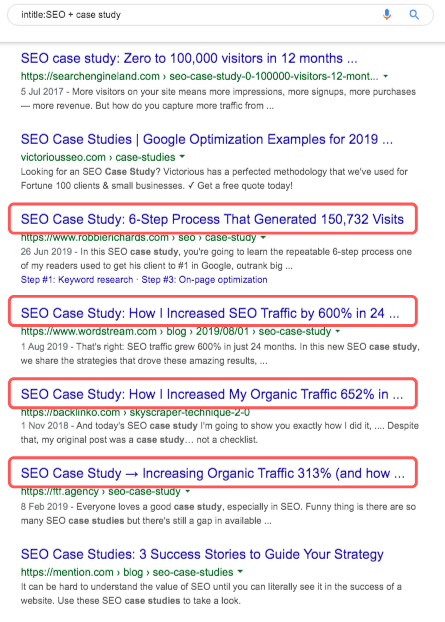
Chances are that most of these pieces of content will also have a large number of links from other websites.
Original research is one of the most popular types of assets that get links. As we saw earlier, with websites like Ahrefs or Backlinko, studies and original research usually attract a lot of links. What it is about original research and studies that make people want to share and link back to this type of content in the first place?
Judging by the success of most of the studies and research online, it’s because:
| Studies have many shareable elements (i.e. data, numbers, graphs, and charts) |
| Studies from authoritative sources give credibility to your own content pieces |
| Studies help you support your statements |
It’s no wonder that research and studies work particularly well. One thing to keep in mind here is that most of these studies – especially the ones that have to do with marketing – prove correlation, not causation.
This means that when a study finds that the number of links can positively affect rankings, this is by no means definitive. Keep in mind that research and studies are usually not something that people will find through regular search queries in Google search.
These types of content are created for the purpose of attracting links and giving authority to the website or blog that published them.
Take Backlinko’s Google Search Results study, which according to Ahrefs, has 3.37K referring domains, but gets only 51 visits per month from organic searches.
 Source: Ahrefs UI
Source: Ahrefs UI
Thus, it is evident that most of the time these pieces of content are created to attract links and not traffic. The reason why they get so many links is exactly because they contain elements that are link-worthy.
In Backlinko’s case, it’s industry-specific data…
 Source: Backlinko
Source: Backlinko
…nice charts and graphs…
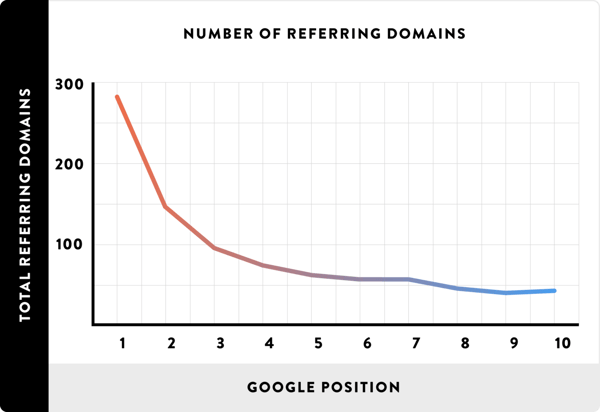
Source: Backlinko
…or interesting statements like the following:
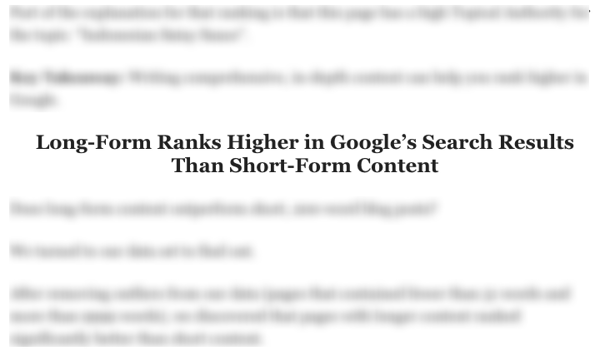 Source: Backlinko
Source: Backlinko
All of these micro-elements paint the big picture of a linkable asset that’s both shareable and link-worthy.
Tools and lead magnets is another type of linkable asset that gets links and often shares on social media.
A good example here is the tool Clearbit Logo by Clearbit.
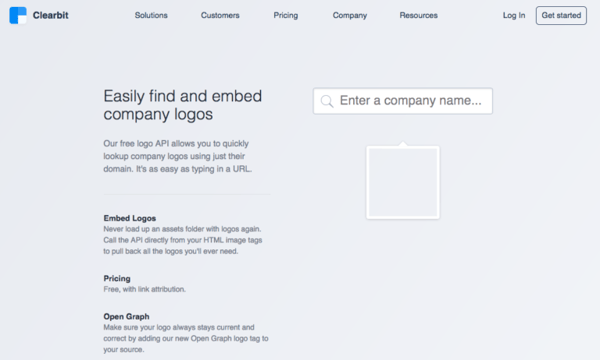
Source: Clearbit
Clearbit Logo allows users to find and embed company logos on their own websites.
Seems simple, right? However, this basic tool has links from 66 different domains according to Ahrefs.

Source: Ahrefs UI
Was it difficult to build? Probably not. Does it help Clearbit to have a strong backlink profile? Definitely.
The benefit of creating such a linkable asset is not only connected to getting leads. It’s also a great way to have visitors experience the value of your product, by offering a free taster that’s easy-to-use and has a low time-to-value (TTV). In Clearbit’s case, this was a free logo API.
For an insurance company, it could be an insurance calculator:
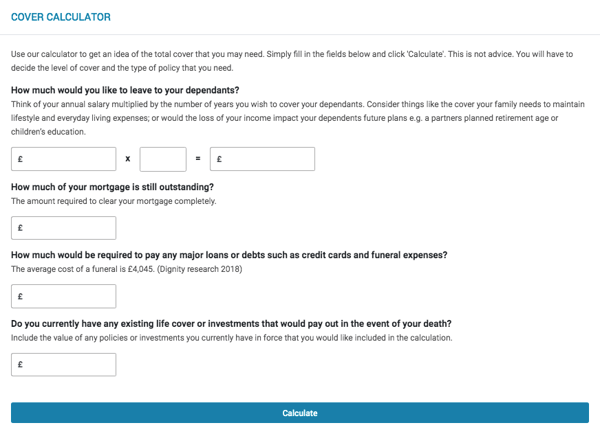
Source: Legal & General
Or if you were a storage company, it could be a storage calculator:
 Source: STORED
Source: STORED
In any case, these tools – which for software companies can be referred to as product lead magnets – are a great way to generate links and create some buzz around your products and services.
The good thing about list posts is that they are relatively easy to create and at the same time have a high perceived value for the visitor. It’s true that list posts don’t require as much time and resources as studies, research, infographics or any other linkable asset.
However, they are just as effective – if not more so – as other linkable asset types. There is one caveat here though: most people are trying to create lists using the wrong value metric.
This means they’re trying to outrank what’s out there by creating a version with more tools (for instance) than the other lists which already exist on that topic. This is the wrong approach and shows that you’re not paying attention to the needs of your audience.
For example, let’s assume you’re looking for video editing software tools online.

One of the first results on Google search comes from G2 Learning Hub.
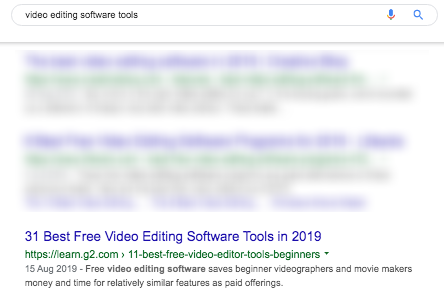
|
TIP: You can see the full list of video editing software solutions directly on G2's site! |
The reason why this piece ranks so high is because someone looking for video editing software tools is obviously considering which tool to use. The readers in this situation may not need as many video editing software tools, but only the best tools as categorized by capabilities, cost or other criteria.
Thus, creating a list with “150 video editing software tools” would make no sense here. In fact, this would confuse your readers rather than do any good. What I’m trying to say is this: don’t overdo it with your list posts. Always try to create the best content piece possible, but try to be practical as well.
Besides ranking highly, this piece by G2 Learning Hub attracts a lot of links, as you can see below.
 Source: Ahrefs UI
Source: Ahrefs UI
When it comes to list posts, it’s therefore all about creating the best possible version of the list post rather than the biggest or the most extravagant.
Trends and statistics is another type of asset that attracts links.
You may be wondering why, but it’s obvious. Content pieces with trends and statistics include information that people can link back or refer to now. This means that they’re relevant for a certain period of time.
If you take, for example, “The Top 20 Reasons Why Startups Fail” by CB Insights, you’ll notice some interesting things. To begin with, this piece has 37.9K backlinks from 1.84K unique referring domains.
 Source: Ahrefs UI
Source: Ahrefs UI
At the same time though, this piece doesn’t get as much organic traffic (for reasons I explained earlier) and thus doesn’t have much commercial value.
Nevertheless, this is a successful content piece in terms of link acquisition. What’s even more interesting is that over the last 7 days, this piece has gained 55 new links. Most of these links are using either a certain percentage or number from the study as anchor text.

Source: Ahrefs UI
This will continue to happen for as long as the piece is relevant, which means that you won’t be able to refer to a content piece that was created back in 2018 when it’s 2021.
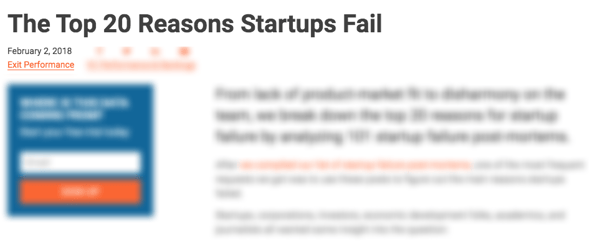
Source: CB Insights
In other words, trends and statistics may work really well, but you have to update them at least one per year in order to maintain their relevance.
The sixth type of content that will help you build links is infographics.
As mentioned earlier, infographics were very popular back in 2013. This doesn’t mean they’re not working at all anymore. It just means that in most cases they’re not as effective as they used to be. Nevertheless, infographics may still be a good opportunity for many industries and across different verticals.
|
TIP: In order to create stunning infographics, you're going to need to use the right graphic design software. Find the perfect solution for your needs on G2. |
G2 Learning Hub has four infographics published, from which the one about digital marketing statistics seems to stand out.
 Source: Ahrefs UI
Source: Ahrefs UI
This content piece has 1,228 backlinks from 45 unique referring domains.
The infographic is well-designed…
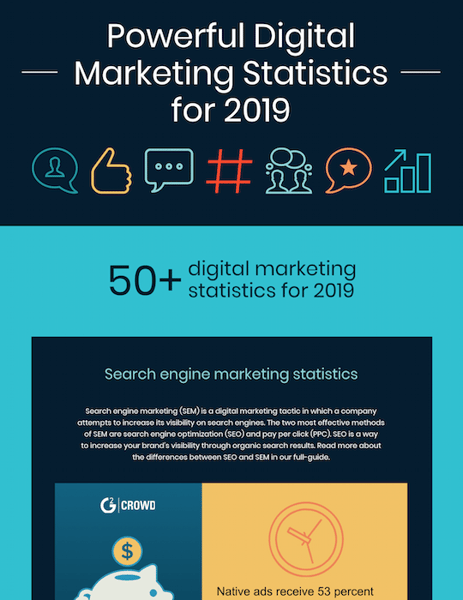
…and includes useful information that people want to refer and link back to.
G2 has also broken down the infographic into smaller graphs that include certain pieces of information.
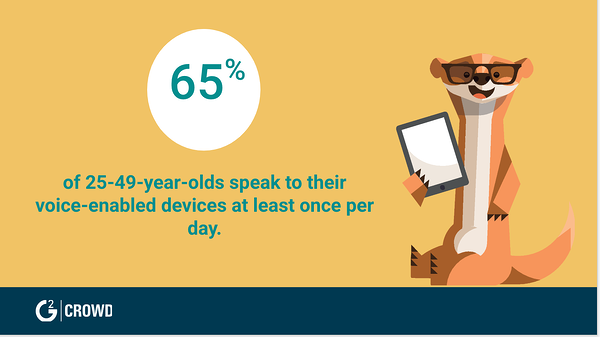
People may not be able to copy and paste the whole infographic into their own website or blog since it’s 18,156 pixels, but they can definitely use those small graphics in their own content.
Tip: Check out the different types of infographics!
With these practices, you'll also be able to garner links for any type of content. As you can see, there are many ways in which you can create a linkable asset.
You need to find the ones that you can support with your capabilities and resources in order to create a piece of content that truly stands out.
Learn all of the tricks of the trade and get your content – and site – noticed online. Put this information to use and make sure your linkable assets lead to impressive traffic, just like G2 experienced in one year.
Georgios Chasiotis is a marketing consultant who drives organic growth for SaaS & tech companies through Content & SEO. He runs a strategy and consultation agency, and is based in Thessaloniki, Greece. Georgios has previously written for sites and publications like GrowthMentor, LeadFuze, lemlist, LongTailPro, ContentStudio, Marketing & Growth Hacking and HackerNoon. In his free time, he reads psychology and tries to understand the “why” behind human behavior. To learn more about Georgios, you can connect with him on LinkedIn and Facebook.
If you've at least used some form of writing or web content management software, there is a...
 by Kai Tomboc
by Kai Tomboc
Learning management systems, or LMSes, are strategic investments.
 by Krystal Tolani
by Krystal Tolani
We usually take pictures on our smartphones or cameras and then upload them to a computer.
 by Svitlana Shapovalova
by Svitlana Shapovalova
If you've at least used some form of writing or web content management software, there is a...
 by Kai Tomboc
by Kai Tomboc
Learning management systems, or LMSes, are strategic investments.
 by Krystal Tolani
by Krystal Tolani


